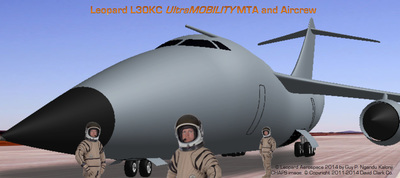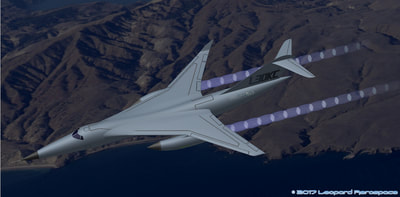Leopard L30KC UltraMOBILITY
Supersonic Military Transport Aircraft
The Leopard L30KC UltraMOBILITY is a supersonic medium-sized, long range, and twin-engine jet-powered military transport aircraft (MTA) concept under development by Leopard Aerospace. Initially, the aircraft has been designed to be proposed to the United States Air Force’s Air Mobility Command in the objective is complete the fleet for military missions as well as humanitarian missions.
Enhance your Army’s Future Combat Systems (FCS) vehicles. The project aims at a supersonic MTA and tanker in option because one L30KC aircraft is enough to make the same operation that several conventional MTAs. With the L30KC, you will get all records in diverse mission demands in the world. This high speed air transport facilitates setting up a genuine specialized rapid response force.
- New generation long-range transport compared to current MTAs.
- Short-haul flight (< 3 hours) with Mach 3 cruise, high operational efficiency.
- Humanitarian mission such as homeless from typhoon, distant disaster zone by an earthquake.
- Rapid intervention by flying over enemy missile zone with Mach 3 cruise (or more).
- In-flight refueling capability.
- Self-protection systems: countermeasures, missile sensor, and jammer.
- High capability to land and takeoff on small airfield and rough strip safety.
- Few round trips, hence less sleepiness for all L30KC aircrew.
Note: For safety, neither aerial delivery system, paratroops launching, nor aerial refueling is operated during supersonic flight. Thanks to the integration of variable cycle engine (VCE) system, such operations are conducted at subsonic flight. The L30KC is also equipped for low-altitude parachute extraction system (LAPES) drops.
Why Such Innovation?
Only one supersonic L30KC aircraft with maximum payload of 66,100 lb (30 t) at Mach 3 cruise can improve some returns missions of several subsonic MTAs reunited. For instance, 250,000 lb (113 t) of load are transferred to a destination of 2,500 NM (4,630 km) only in 4 returns in 10 hours at least of 6 returns in 3.5 days with a C-130J-like.
In other words, if the aircrew of two types of transport aircraft begin their mission at 6:00 AM, the aircrew members of supersonic L30KC may go home to their families on the same day in the early evening. While aircrew members the conventional transport aircraft will return home only after 3 to 4 days and exposing themselves to big fatigue and danger from the ground if a discrete enemy observes the numerous passages.
Is your budget limited? From now, due to its high speed, it is not necessary to order a hundred of supersonic transport aircraft. It is also not necessary to form as many crew. Only few fleets with L30KCs are sufficient. Your future strategic and tactical mission is more clearly performed.
Specifications
Cargo Compartment
Have the courage to project a world more secure to the level of Head of State. Here, an official state visits procedure by a very short trip at Mach 3, thereby saving time and resources for the President’s Secret Service agents. The President’s Limousine is carefully unloaded from a Leopard L30KC UltraMOBILITY military transport aircraft before he arrives in own Air Force One.
Mix of troops, palletized cargo, and 15-metric ton vehicles.
Dimensions of cargo compartment.
Performance
Multi-rang circles of 3,764 NM / 6,971 km (30 t), 5,026 NM / 9,309 km (20 t), 6,587 NM / 12,200 km (Ferry) from BTR.
Tanker Capability
The Fuselage Refueling Unit (FRU) transforms the aircraft to a tactical tanker, i.e. the capability to transfer fuel from L30KC to another aircraft in flight phase and particularly another L30KC. The FRU, that have the same role that the wing pods known as Wing-Mounted Aircraft Refueling Pods (WARP), is mounted in a center line configuration to the back of the aircraft for use in aerial refueling. As receiver also, the L30KC has two possible aerial refueling systems, located over the cockpit, that have the ability to receive fuel in-flight from another tanker. The first, included on aircraft, is a retractable probe at left side of the cockpit. The second, in option, is a receptacle at center called Universal Aerial Refueling Receptacle Slipway Installation (UARRSI). Both equipment have the capability to provide an unlimited range.Above image, the FRU: When Air Force needs to search for survivors from distant disaster zone. The L30KC aerial refueling system capability allows the receiver aircraft, here an helicopter crew, to continue search and rescue missions for several hours. Below image, the retractable probe: Unlike fixed probe, retractable configuration improves considerably the aerodynamic during supersonic flight.
|
Supersonic Air Breathing Propulsion
The TFR68 “PULSAR” (Leopard Aerospace designation) engine is a concept under development by Leopard Aerospace for supersonic air breathing propulsion. The all-new engine has been exclusively designed to power continuously the Leopard L30KC UltraMOBILITY MTA. The engine is a hybrid afterburning turbofan/ramjet mode. It produces a maximum of 68,000 lbf (302 kN) of thrust. The variable cycle engine (VCE) configuration allows operating in subsonic, transonic, and supersonic flight by selecting optimized altitude from zero to service ceiling. Its ability to run at high altitude saves considerably fuel weight. The VCE is safer for paratroop and airdrop operation, and very important to facilitate aerial refueling. The external complex design is governed by the oblique shock of nose cone during the cruise speed. The inlet spikes are slightly inclined following the deflection angle in the zone of action, thus, optimizing the airbreathing propulsion system. The engine should be affordable as required by the U.S.A.F. and the U.S. DoD. The collaboration with Pratt & Whitney or GE Aviation of the United States, due to their numerous innovative projects, is desired in the objective to accelerate the development of new engine technologies.
The TFR68 engine is to take advantages of CAx software’s new technologies for the design and the high temperature materials (HTMs) to launch an innovative power for the aircraft. Thank to these, it is possible to develop an all-new engine, to test its performance, and to complete first flight in less than eight years. Decreasing the interval between demonstrations of technology in major propulsion systems will increase the rate of technology development.
The TFR68 engine is to take advantages of CAx software’s new technologies for the design and the high temperature materials (HTMs) to launch an innovative power for the aircraft. Thank to these, it is possible to develop an all-new engine, to test its performance, and to complete first flight in less than eight years. Decreasing the interval between demonstrations of technology in major propulsion systems will increase the rate of technology development.
|
3-Stage Fan and 7-Stage Compressor with Integrally Bladed Rotors (IBRs)
Unlike the conventional inserted blades, the TFR68 engine benefits with the integrally bladed rotors (IBRs) in the fan and the compressor. The IBRs are an assembly of blisks (blades and disks) forming one piece in a geometric complexity where Leopard Aerospace is proficient and foremost in the modeling techniques. The IBRs have the following major advantages: - Weight reduction; - Low vibration at supersonic cruise; - Flutter avoidance; - Low cost in health monitoring and prognostics; - Long warranty on the blades; - More safety (FOD avoidance); - Titanium (Ti) materials. |
Avionics
|
The L30KC avionics suite that have need to be developed with expert partners, will be the most advanced in matter of tactical flight management system, in-flight refueling (IFR), formation flight, rendezvous operations, and a control system for automatically loading and unloading vehicles and pallets from cargo compartment under combined vision system (CVS).
The CVS, under FAA’s 14 CFR § 91.175 (l) Operating Requirements and RTCA’s DO-315A standard, will benefit both Synthetic Vision Primary Flight Display (SV PFD) and Enhanced Vision System (EVS), all Enhanced Situational Awareness System (ESAS) for increase safety. One time the security code will be unlocked by the pilots, it will be simple and easy to use for military air transport. The fully integrated electronic cockpit of L30KC accommodates pilot and co-pilot to operate all systems on any type of mission with the cargo system. An observer position could be envisaged following customer. The digital avionics system has four high-resolution LCD multi-function displays (MFD), two full-capability head-up displays (HUD). The L30KC smart vision system, including moving map, is not a futuristic concept, but beautiful and well realistic and realizable project adapted for supersonic flight today.
|
MLG Pods-less Concept
|
Each MTA has its own unique mechanism for retraction and extension of main landing gear (MLG). In the case of high speed L30KC UltraMOBILITY aircraft, the supersonic law constraints the design of cargo compartment to be different of conventional MTA design. The area rule, that imposes the fuselage to be narrowed at the location of the wing and MLG pods-less concept, go up the floor level to left space for MLG wheel well. Thus, the main movements of MLG during retraction and extension are the rotation and translation. Before it is retracted after takeoff, the MLG rotates 90° degrees vertically and translates horizontally for a smaller length to be accommodated inside the wheel well.
On the ground, to facilitate vehicle loading and unloading, the aircraft is configured with kneeling landing gear system. This system permits lowering of the parked aircraft, so the angle of cargo ramp is low. |
Basic CAD Model showing the MLG both fully retracted and extended.
|




























